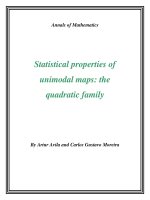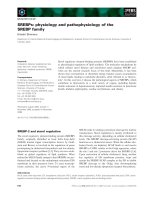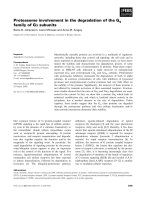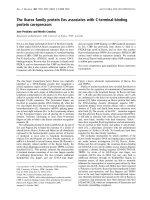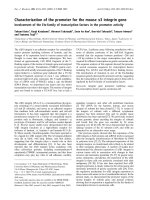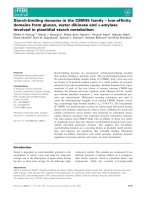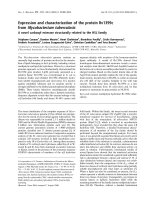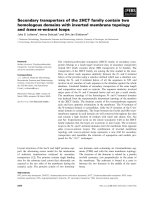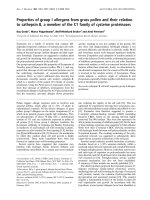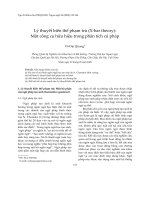The NSSI family distress cascade theory
Bạn đang xem bản rút gọn của tài liệu. Xem và tải ngay bản đầy đủ của tài liệu tại đây (1.21 MB, 6 trang )
Waals et al.
Child Adolesc Psychiatry Ment Health
(2018) 12:52
/>
Child and Adolescent Psychiatry
and Mental Health
Open Access
RESEARCH ARTICLE
The NSSI Family Distress Cascade Theory
Lisa Waals1* , Imke Baetens1, Peter Rober2, Stephen Lewis3, Hanna Van Parys4, Eveline R. Goethals2,5
and Janis Whitlock6
Abstract
Nonsuicidal self-injury (NSSI) is a complex behaviour and occurs most commonly during adolescence. This developmental period is characterized by the drive to establish an equilibrium between personal autonomy and connectedness with primary caregivers. When an adolescent self-injures, caregivers often experience confusion about how to
react. Reports of feeling guilt, fear, and shame are common in the wake of learning about a child’s self-injury. This
cascade of negative feelings and self-appraisals may lead to hypervigilance and increased caregiver efforts to control
the child’s behaviour. The adolescent may experience this as an intrusion, leading to worse family functioning and
increased risk of NSSI. This cascade is not well acknowledged or articulated in current literature. This article remedies
this gap by presenting the NSSI Family Distress Cascade.
Keywords: Nonsuicidal self-injury, Self-harm, Parental secondary stress, Family life cycle, Cascade model
Introduction
Non-suicidal self-injury (NSSI) is defined as the direct,
deliberate destruction of one’s own body tissue without
suicidal intent [1] and includes behaviors such as cutting, burning, and hitting oneself. The risk for engaging in NSSI is particularly high in adolescence, in which
the onset is consistently found to be around 14-years of
age [2, 3] and lifetime prevalence rates are about 17% in
community samples [4]. Engagement in NSSI is strongly
associated with various adverse mental health outcomes
such as low self-esteem, depression, anxiety, and suicide attempts [5, 6]. Accordingly, it is unsurprising that
the most common function of NSSI reported in nonclinical samples of adolescents is regulation of difficult
and intense thoughts and feelings. Several recent studies [7, 8] suggest that NSSI in adolescence is a predictor
for depression, anxiety, and suicide attempts later in life.
Taken together, NSSI represents an important public
health concern for today’s youth.
In line with its functions, in the emotional cascade
model [9], NSSI is described as a result of a ruminative
process (to an emotional stimulus) which results in a cascade which gradually increases emotional intensity and,
ultimately leads to emotional dysregulation. The emotional cascade model asserts that NSSI serves as a form
of distraction which temporarily reduces negative emotion and increases a perception of relief or even wellbeing. In this way NSSI represents a negative reinforcer in
the emotion–behavior interaction. A more recent NSSI
functional model, namely, the Cognitive-Emotional
Model of NSSI [10], suggests that a number of cognitive processes also play a role in this emotional cascade
to reinforce the behaviour. Importantly, the new model
underpins the complex associations between cognition,
emotion and behavior at an individual level. In another
conceptual model, Hooley and Franklin [11] take into
account some interpersonal factors (such as abuse/maltreatment/victimization and peer NSSI) in addition to
the above factors. However, these interpersonal factors
are only considered the level of triggers for NSSI. Notwithstanding the importance of these models, a conceptual framework to understand the interaction between
NSSI and the environment is absent in current literature.
The current paper presents a theoretical framework to
understand the interaction between NSSI and the caregiver/adolescent relationship, which can be a first step
to understand the interaction between NSSI within a
broader context.
*Correspondence:
1
Vrije Universiteit Brussel, Brussels, Belgium
Full list of author information is available at the end of the article
© The Author(s) 2018. This article is distributed under the terms of the Creative Commons Attribution 4.0 International License
(http://creativecommons.org/licenses/by/4.0/), which permits unrestricted use, distribution, and reproduction in any medium,
provided you give appropriate credit to the original author(s) and the source, provide a link to the Creative Commons license,
and indicate if changes were made. The Creative Commons Public Domain Dedication waiver (http://creativecommons.org/
publicdomain/zero/1.0/) applies to the data made available in this article, unless otherwise stated.
Waals et al. Child Adolesc Psychiatry Ment Health
(2018) 12:52
The interaction between NSSI and the caregiver–
adolescent relationship
Beyond its well-documented effects on those who selfinjure, NSSI also has a significant impact on entire (family) systems [12–14]. After discovering a family member
self-injures, most families experience acute stress and
a sense of crisis. When caregivers find out about their
child’s NSSI, they often feel overwhelmed and experience
myriad emotions (e.g., anger, fear, guilt, confusion) [12–
15]. Indeed, the impact of NSSI on caregivers through
secondary stress/distress, can disrupt family dynamics
and impede family functioning [16, 17].
In the (cross-sectional) studies examining the relation
between NSSI and family processes to date, there exists
a clear negative association between NSSI and a variety
of family factors. For example, studies examining family
functioning from the adolescent perspective, find that
youth who self-injure report less emotional support,
more criticism, and excessive behavioral control from
family members [18] when compared to youth who do
not self-injure. Furthermore, adolescents who self-injure
also report being less securely attached to their caregivers [19]. Indeed, it is not uncommon for adolescents who
self-injure to view their relationship with caregivers as
unreliable and to believe that they may not be worthy of
care. They also report difficulties integrating experiences
across multiple levels of thinking and feeling (e.g., they
may have a harder time adopting different perspectives),
and difficulty forming reciprocal and empathic relationships with their caretakers [20].
The negative association between a variety of family
factors and NSSI found in cross-sectional (adolescentreported) studies is often interpreted causally. However,
in the context of longitudinal and multi-informant studies, a more nuanced interaction between NSSI and the
family emerges. For example, findings from longitudinal studies [12] show a dynamic and reciprocal pattern
of influence between a child’s NSSI and parenting. Specifically, longitudinal research suggests that NSSI elicits
more controlling (e.g., rule setting) parenting behaviors,
which, in turn, is associated with more severe engagement in NSSI [12]. To this end, NSSI seems to impact the
whole family system and can push a family system into
crises.
In multi-informant studies, extant literature suggests that having a child who self-injures has a clear, and
often adverse, impact on caregivers [14, 15, 21]. Indeed,
researchers have suggested that managing care for a child
who self-injures can result in “secondary stress” that is
characterized by difficult thoughts and feelings (e.g.,
guilt, worry, or judgement) about the source of stress
(such as a child who self-injures) or even oneself. This, in
Page 2 of 6
turn, can detrimentally impact daily life (e.g., logistical,
emotional, attitudinal) [22].
Having a child who engages in self-injury can raise particular challenges as it tends to be episodic and thus difficult to anticipate [14]. As a result, caregivers of youth
who self-injure often end up feeling overwhelmed or
unable to manage their child’s needs [14, 15]. This, in
turn, can lead to “empathy burnout” in which a parent
becomes increasingly unable to respond in a compassionate way [23]. Chronic secondary stress can exacerbate
self-injury duration and, in turn, reinforce negative family or parenting dynamics [18, 24]. For example, in a qualitative study by McDonalds, O’Brien, and Jackson [15],
found that after NSSI was disclosed, mothers of children
who self-injure reported high levels of perceived loneliness as well as fear of judgement by others in their peer
groups (e.g. other mothers and fathers). Such feelings can
inhibit reaching out to others, thereby increasing social
isolation [12, 14, 16].
Confusion about why a child self-injures (and general
misunderstanding about NSSI) can also affect parents.
For instance, caregivers report feelings of insecurity,
guilt, shame and a sense of personal responsibility for the
fact that their child self-injures [12]. Furthermore, a lack
of support coupled with a poor understanding of NSSI
can hinder both the connection and effective communication with the child [14, 18, 24]. Moreover, fear about
future episodes of NSSI or a suicide attempt can be paralyzing for caregivers who feel like they are “walking on
eggshells” in anticipation of a future negative event that
they cannot predict or control [15]. Finally, chronic emotional, social and practical (e.g., financial) strains can further compound the manner by which caregivers interact
with and support their child [25].
The aforementioned cascade of aversive feelings and
self-appraisals, along with confusion about how to best
respond to their child, may lead to hypervigilance and
increased efforts to control their child [12]. On the one
hand, this control may be a way to deal with their own
fear and insecurity. On the other hand, this may be perceived as intrusive by adolescents and may further strain
family dynamics and increase the risk of NSSI [3]. To
date, this family dynamic cascade is not acknowledged or
well described in current NSSI literature. To address this,
we present “The NSSI Family Distress Cascade.”
The NSSI Family Distress Cascade Theory
This NSSI Family Distress Cascade Theory is interwoven
with the psychosocial stages of development of adolescents (Identity vs. Role Confusion; [26]) and family life
cycle stages of families with children in adolescence.
Adolescence stands out among other stages in the family life cycle for its association with what can feel like
Waals et al. Child Adolesc Psychiatry Ment Health
(2018) 12:52
tectonic shifts in family dynamics. Family equilibrium
can be elusive in this period, largely because it is a period
marked by dynamic tension between adolescent needs
for both autonomy and connectedness. This can be challenging in and of itself, but is exacerbated by emotional
and hormonal changes within the child and, often, a lack
of understanding among caretakers of normative adolescent emotional and social development. As can be seen
in Fig. 1, these factors may impede finding a new equilibrium within the family.
When normal shifts and challenges in family functioning are combined with mental health challenges, such as
NSSI, family wellbeing can flounder. Since adolescence is
the most common age of onset for NSSI [27], it is common for family systems to be impacted. Since adolescents sometimes injure themselves as a means to obtain
relief from feelings of insecurity, self-doubt, and distress
[1], the function of NSSI can interact with normative
Page 3 of 6
developmental drives and make parenting even more
challenging. Caregivers, in particular, are often hard
pressed to understand and navigate complex interactions
while also setting effective policies and norms that work
for everyone.
In the same way that there are patterns in family life
cycles over time, the introduction of NSSI into a family system can be patterned enough to be described as a
framework. As can be seen in Fig. 2, in the first stage, it is
common for adolescents to keep NSSI hidden from their
primary caregivers (e.g. [28, 29]), which may contribute to
a sense of autonomy for the youth. Indeed, many adolescents describe NSSI as a symbol of autonomy [19]. Such
secretiveness, however, is often noticed by caregivers
who are well acquainted with the youth. While caregivers may not know what the youth is experiencing specifically, they often suspect that something is amiss (e.g.,
due to changes in social engagement or mood). At this
Fig. 1 Family life cycle
Fig. 2 NSSI during adolescence finding an equilibrium between connectedness and autonomy
Waals et al. Child Adolesc Psychiatry Ment Health
(2018) 12:52
stage caregivers may start to ask questions with the aim
of understanding the source of their worry or as a means
of reassuring themselves that there is not real cause for
worry. These questions, though often well-intended, can
be experienced as threatening to adolescent autonomy,
which may compromise the sense of connectedness a
youth has with the parent. This can exacerbate the need
for secrecy and control which, in turn, increases parental suspicion, worry, and their pursuit to understand what
is happening with their youth. In other words, the more
secrecy on the part of the adolescent, the more caregivers may amplify their efforts to determine the source of
stress.
Once this cycle starts, it can be difficult to interrupt.
When NSSI is disclosed, parents often react with controlling behaviors (e.g., checking text messages or grounding
their child) [24, 28, 29]. Adolescent may see these reactions as intrusions of privacy and overbearing parental
hypervigilance [29, 30] as well as a threat to their autonomy. In turn, this may result in increases NSSI frequency
and severity. Furthermore, in these times of family distress, the levels of stress, negative emotions and feelings
of guilt in adolescents increase. To this end, the resultant
cascade can further adversely impact NSSI.
The abovementioned escalating processes between
the youth and their worried caregivers can be referred
to as complementary schismogenesis [31] or complementary escalation [32]. Both concepts have been described
in the family systems literature to describe the development of problems or pathology (e.g. [32]). A common
feature of these processes is that each of the participants
involved view their behaviour as the only sensible reaction to the behaviour of the other. In addition, both participants tend not to be aware of the overarching pattern
in which they push the other to do exactly what they do
not want the other to do. In the context of NSSI, the adolescent is in search of autonomy but pushes the caregivers to control him/her even more (e.g., How can I decide
for myself when mom and dad tell me what to do? How
can I be myself if they know everything about me?). In the
case of caregivers, they want reassurance that their child
is doing fine, but they push their child into more secret
self-injuring behaviour as their only means to have a
sense of autonomy. The caregiver’s persistent search for
reassurance that their child is doing fine, may be understood by the adolescent as evidence that the caregivers
do not want their child to be autonomous or that this
is not valued. Indeed, youth may perceive their parents’
efforts as a means of control. Ultimately, this feeds adolescents’ resolve to not give in, and to guard their privacy
(including how he/she deals with their body). This is consistent with recent research indicating that there is a positive association between NSSI and perceived parental
Page 4 of 6
control and identity issues [18], and a negative association between NSSI and perceived care [33].
In summary, on an individual level, NSSI offers relief.
It is often a way of coping with the feelings of insecurity,
self-doubt, and distress. On a family level, NSSI often
plays a part in the adolescent’s search for identity and
autonomy, within an attachment relationship.
Discussion: ideas for future research and treatment
In this paper we propose a different way of looking at
the crisis within families in which a young person selfinjures. Specifically, we propose a cascade theory that
highlights the dynamic and reciprocal relationship
between the adolescent who self-injures and the family.
Despite many hypotheses about familial risk- and protective factors in NSSI, few studies have examined the
bi-directional relationship between NSSI and family
functioning. Most research uses retrospective methods,
as well as adolescent-reported measures on potential
familial risk factors. Although self-report approaches
provide insight into adolescent perspectives, longitudinal multi-method designs (including parent-report data)
are necessary for disentangling the interactive aspects of
youth and caregiver factors since they elucidate the views
of all parties involved. For example by using cross-lagged
models, the interaction between caregivers reactions on
NSSI and adolescents NSSI behaviors can be examined.
Or to clearly map the complementary schismogenesis (i.e.
the escalating processes) as described in NSSI Family Distress Cascade Theory momentary assessment can shed
light on the complementary escalation of both parent and
child. By researching multiple informants over a period
of time one can begin to unravel the complexities and
examine the role of negative cognitive biases of adolescents, and parental secondary distress after discovery of
NSSI. To align the treatment for NSSI with these interactional processes between the needs of families and the
needs adolescents who self-injure, qualitative research
is needed to explore the experiences of adolescents who
self-injure and their family with therapy, what are the
helping factors and what are the hindrances they occur
when seeing a therapist,…
Towards a therapeutic answer
The NSSI Family Distress Cascade Theory, underscores
the important role of systems and family therapies in
NSSI treatment. It clearly suggests that family therapy,
focusing on the strengths and resources of the child and
their family within a systems context, may have utility in
helping family members to better understand the nature
of the patterns in which they may be caught. Furthermore, a family therapist can help family members to fully
experience their love and care towards each other.
Waals et al. Child Adolesc Psychiatry Ment Health
(2018) 12:52
We expect different outcomes in systemic therapy than
solely the cessation of NSSI. Systemic therapy focusses on
the strengths and resources of the child and their family
within the system. This may help family members to have
a better understanding of the nature of patterns in which
they might be caught. Furthermore, a family therapist
can help family members to express their love and care
towards each other. Research is needed to specify and
identify actionable factors in the systemic approach of
the adolescent who engages in NSSI and their family, in
order to develop family interventions that are more tailored to the specific needs of each adolescent and their
families. For example, the more cost-effective multi-family group interventions [34] may provide ample opportunities for caregivers and adolescents to discuss NSSI and
its meaning for adolescents as well as for their families.
In multi-family group intervention, adolescents as well as
caregivers additionally benefit from the support of other
adolescents and caregivers. Integrating a psycho-educational component in these interventions for caregivers on
age-appropriate and qualitative involvement and communication with their adolescent about the NSSI might
be meaningful.
Conclusion
Within this paper we highlighted the importance of
looking at NSSI and family dynamics in the context of a
reciprocal process that impedes equilibrium in the family. While we apply this theory to NSSI in particular here,
we expect that the NSSI Family Distress Cascade Theory
has salience for a variety mental health challenges that
families face. We also surmise this model having relevance for emerging adults. Understanding this model in
the context of different caregivers may also have merit.
For example, Hilt and colleagues suggest that mothers
and fathers react differentially. In particular, they indicate
that the father-child relationship will be more influence
by situational factors, compared to the mother–child
relationship. Further research, however, is needed to better understand these patterns and how this may fit within
the currently proposed model.
Taken together, the current the NSSI Family Distress
Cascade model may not only have empirical and clinical
germanenes in the context of NSSI, as discussed above,
but may also have applicability and relevance across a
range of contexts.
Authors’ contributions
The paper was a team effort from all the co-authors. IB, JW and SW are experts
in NSSI and the family context. They focused on the holistic approach, we
used in this paper. The contributions of PR, EG and HVP completed this paper,
as they are experts in family therapy. They cross-checked if our findings
were also applicable in practice. LW incorporated all their remarks and new
research. All authors read and approved the final manuscript.
Page 5 of 6
Author details
Vrije Universiteit Brussel, Brussels, Belgium. 2 Katholieke Universiteit Leuven,
Leuven, Belgium. 3 University of Guelph, Guelph, Canada. 4 Universiteit van
Gent, Ghent, Belgium. 5 HARVARD Medical school, Boston, USA. 6 Cornell
University, Cornell, USA.
1
Acknowledgements
Not applicable.
Competing interests
The authors declare that they have no competing interests.
Availability of data and materials
Not applicable.
Consent for publication
Consent from all the co-authors was granted.
Ethics approval and consent to participate
Not applicable.
Funding
Not applicable, no funding was granted.
Publisher’s Note
Springer Nature remains neutral with regard to jurisdictional claims in published maps and institutional affiliations.
Received: 10 September 2018 Accepted: 8 December 2018
References
1. Nock MK, Favazza AR. Nonsuicidal self-injury: definition and classification. In: Nock MK, editor. Understanding nonsuicidal self-injury: origins,
assessment and treatment. Washington, DC: American Psychological
Association; 2009. p. 9–18.
2. Gandhi A, et al. Age of onset of non-suicidal self-injury in Dutch-speaking
adolescents and emerging adults: an event history analysis of pooled
data. Compr Psychiatry. 2018;80:170–8.
3. Muehlenkamp JJ, et al. International prevalence of adolescent nonsuicidal self-injury and deliberate self-harm. Child Adolesc Psychiatry
Ment Health. 2012;6(1):10.
4. Swannell SV, et al. Prevalence of nonsuicidal self-injury in nonclinical
samples: systematic review, meta-analysis and meta-regression. Suicide
Life Threat Behav. 2014;44(3):273–303.
5. Victor SE, Klonsky ED. Daily emotion in non-suicidal self-injury. J Clin
Psychol. 2014;70(4):364–75.
6. Whitlock J, et al. Nonsuicidal self-injury as a gateway to suicide in young
adults. J Adolesc Health. 2013;52(4):486–92.
7. Kiekens G, et al. The associations between non-suicidal self-injury and first
onset suicidal thoughts and behaviors. J Affect Disord. 2018;239:171–9.
8. Wilkinson PO, et al. Sporadic and recurrent non-suicidal self-injury before
age 14 and incident onset of psychiatric disorders by 17 years: prospective cohort study. Br J Psychiatry. 2018;212(4):222.
9. Selby EA, et al. Emotional cascades and self-injury: investigating instability
of rumination and negative emotion. J Clin Psychol. 2013;69(12):1213–27.
10. Hasking P, et al. A cognitive-emotional model of NSSI: using emotion
regulation and cognitive processes to explain why people self-injure.
Cogn Emot. 2017;31(8):1543–56.
11. Hooley JM, Franklin JC. Why do people hurt themselves? A new conceptual model of nonsuicidal self-injury. Clin Psychol Sci. 2018;6(3):428–51.
12. Baetens I, et al. The association between family functioning and NSSI
in adolescence: the mediating role of depressive symptoms. Fam Sci.
2015;6(1):330–7.
13. Arbuthnott AE, Lewis SP. Parents of youth who self-injure: a review of the
literature and implications for mental health professionals (Review). Child
Adolesc Psychiatry Ment Health. 2015;9:35.
Waals et al. Child Adolesc Psychiatry Ment Health
(2018) 12:52
14. Whitlock J, et al. Parental secondary stress: the often hidden consequences of nonsuicidal self-injury in youth. J Clin Psychol.
2018;74(1):178–96.
15. McDonald G, O’Brien L, Jackson D. Guilt and shame: experiences of parents of self-harming adolescents. J Child Health Care. 2007;11(4):298–310.
16. Byrne S, et al. Deliberate self-harm in children and adolescents: a qualitative study exploring the needs of parents and carers. Clin Child Psychol
Psychiatry. 2008;13(4):493–504.
17. Whitlock J, Lloyd-Richardson E. Healing after self-injury: a compassionate
guide for parents and other loved ones (in press; release date Jan. 2019).
New York: Oxford University Trade Press.
18. Baetens I, et al. The relationship between parental expressed emotions
and non-suicidal self-injury: the mediating roles of self-criticism and
depression. J Child Fam Stud. 2015;24(2):491–8.
19. Gandhi A, et al. Association between non-suicidal self-injury, parents
and peers related loneliness, and attitude towards aloneness in flemish
adolescents: an empirical note. Psychol Belg. 2018;58(1):3–12.
20. Yates TM, Tracy AJ, Luthar SS. Nonsuicidal self-injury among “privileged”
youths: longitudinal and cross-sectional approaches to developmental
process. J Consult Clin Psychol. 2008;76(1):52–62.
21. Zetterqvist M, et al. Prevalence and function of non-suicidal self-injury
(NSSI) in a community sample of adolescents, using suggested DSM-5
criteria for a potential NSSI disorder. Int Soc Res Child Adolesc Psychopathol. 2013;41(5):759–73.
22. Montgomery RJV, Gonyea JG, Hooyman NR. Caregiving and the experience of subjective and objective burden. Fam Relat. 1985;34(1):19–26.
23. Thomas J. Association of personal distress with burnout, compassion
fatigue, and compassion satisfaction among clinical social workers. J Soc
Serv Res. 2013;39(3):365–79.
Page 6 of 6
24. Kelada L, et al. Parents’ experiences of nonsuicidal self-injury among
adolescents and young adults. J Child Fam Stud. 2016;25(11):3403–16.
25. Ferrey AE, et al. The impact of self-harm by young people on parents and
families: a qualitative study. BMJ Open. 2016;6(1):e009631.
26. Erikson EH. Identity and the life cycle. New York: Norton; 1982.
27. Tatnell R, et al. Longitudinal analysis of adolescent NSSI: the role of intrapersonal and interpersonal factors. Int Soc Res Child Adolesc Psychopathol.
2014;42(6):885–96.
28. Baetens I, et al. The effects of nonsuicidal self-injury on parenting
behaviors: a longitudinal analyses of the perspective of the parent. Child
Adolesc Psychiatry Ment Health. 2015;9:24.
29. Baetens I, et al. Non-suicidal self-injury in adolescence: a longitudinal
study of the relationship between NSSI, psychological distress and perceived parenting. J Adolesc. 2014;37:817–26.
30. Baetens I, et al. Non-suicidal and suicidal self-injurious behavior among
flemish adolescents: a web-survey. Arch Suicide Res. 2011;15(1):56–67.
31. Bateson G. Steps to an ecology of mind. New York: Ballantine; 1972.
32. Watzlawick P, Weakland JH, Fisch R. Change: principles of problem
formation and problem resolution. In: Watzlawick P, Weakland JH, Fisch R;
foreword by Milton H. Erickson. New York: Norton; 1974.
33. Bureau J-F, et al. Perceived dimensions of parenting and non-suicidal selfinjury in young adults. Multidiscip Res Publ. 2010;39(5):484–94.
34. Depestele L, Claes L, Lemmens GMD. Promotion of an autonomysupportive parental style in a multi-family group for eating-disordered
adolescents. J Fam Ther. 2015;37(1):24–40.
Ready to submit your research ? Choose BMC and benefit from:
• fast, convenient online submission
• thorough peer review by experienced researchers in your field
• rapid publication on acceptance
• support for research data, including large and complex data types
• gold Open Access which fosters wider collaboration and increased citations
• maximum visibility for your research: over 100M website views per year
At BMC, research is always in progress.
Learn more biomedcentral.com/submissions
